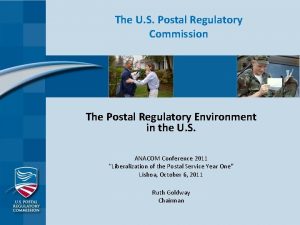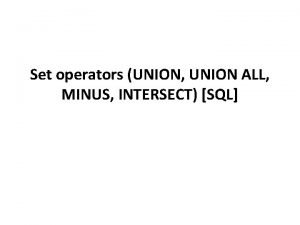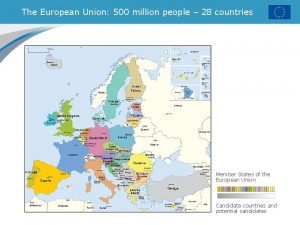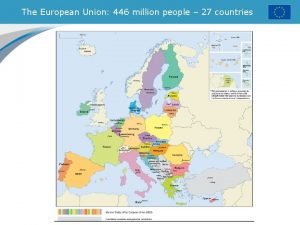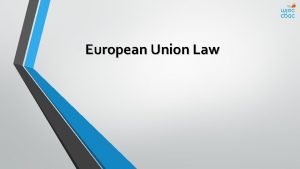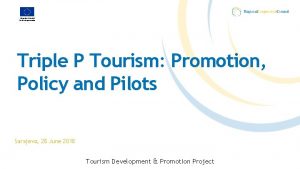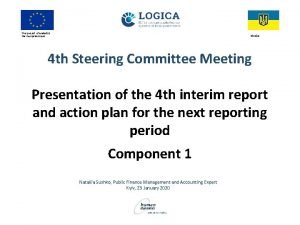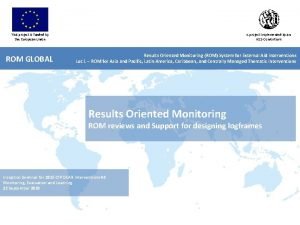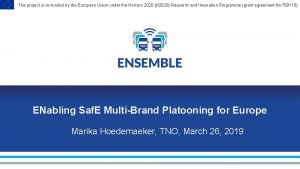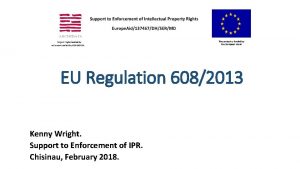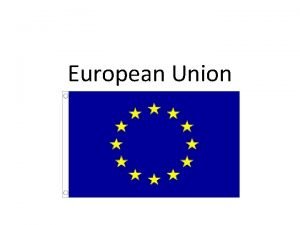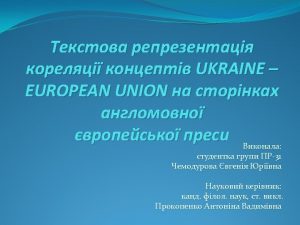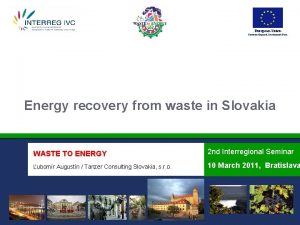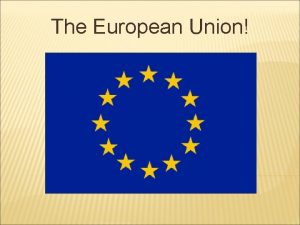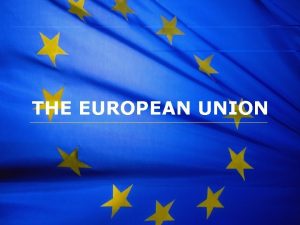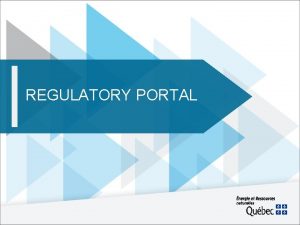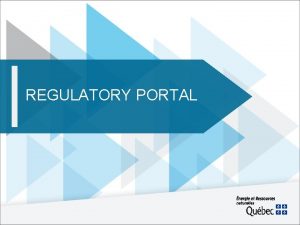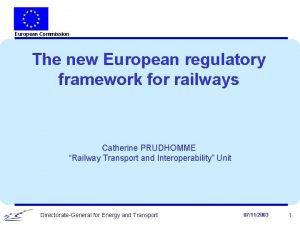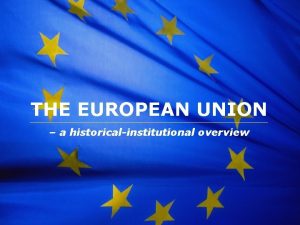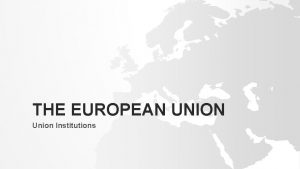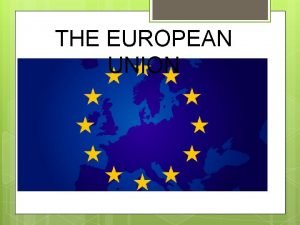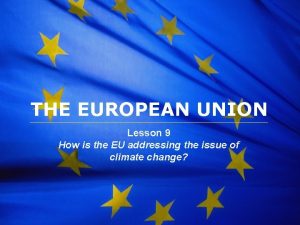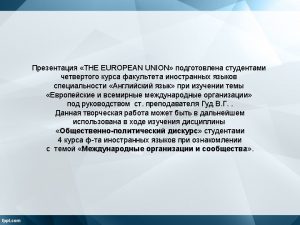European Commission REGULATORY MODEL OF THE EUROPEAN UNION























- Slides: 23

European Commission REGULATORY MODEL OF THE EUROPEAN UNION Norbert ANSELMANN (norbert. anselmann@cec. eu. int) Head of Unit, ENTR G 2, Standardisation Directorate General Enterprise European Commission

REGULATORY MODEL OF THE EU Objective To remove technical barriers to internal EU trade from divergent national technical regulations, stan tests and certification/approval procedures Solutions to ensure free movement of goods - mutual recognition EU-wide technical harmonisation

REGULATORY MODEL OF THE EU COUNCIL RESOLUTION OF MAY LAYING DOWN THE NEW APPRO CONCEPT ON TECHNICAL HARMONISATION AND STANDARDISATION

DRIVING FORCES * Jurisprudence “Cassis de Dijon” : any product legally manufactured and placed on the market in one Member State shall in principle be accepted also in the other Member States, unless the country of destination can claim the existence of imperative requirements to be complied with for reasons of public health, safety, consumer protection, … * Legislative harmonisation of detailed technical legal requirements on product safety proved not to be successfully in major product areas.

DRIVING FORCES * European legislation on safety of electrical equipment – the so- called Low Voltage Directive (73/23/EEC) – making general reference to standards appeared to be a more appropriate solution. * Favourable political framework conditions and commitments : Internal Market programme ‘ 92. * Commitment of stakeholders.

TECHNICAL HARMONISATION * SOLUTION = EU-DIRECTIVES = adopted by the EU legislator = transposed and implemented by Member States * In given sectors (e. g. automotive, pharmaceut food safety) other solutions than the New Appr concept have been applied

NEW APPROACH CONTENT OF THE DIRECTIVES * Definition of the scope, * Essential requirements aiming at ensuring protection of public interests (health, safety, consumer protection, …) * Reference to harmonised standards * Conformity assessment procedures, affixing of the CE marking * Market surveillance

THE NEW APPROACH * * First “New Approach” Directive in 1987 Since then more than 22 products or risks areas have been covered by specific directives, including: Pleasure boats equipment RTT = Machines, Lifts, Pressure equipment, = Medical Devices, in vitro diagnostic = Personal Protection Equipment, Toys, equipment, measurement equipment = Gas appliances, Low Voltage Equipment, construction products

THE NEW APPROACH STANDARDS ARE VOLUNTARY … • Harmonised European standards give a presumption of conformity with essential requirements … but remain voluntary! * European standardisation Bodies CEN / CENELEC / ETSI elaborate European Standards on the basis of requests “mandates” from the Commission; international standards should be transposed uniformingly at European level, wherever they are in line with relevant directives

and standardisation is independent • Standards are not defined by public authorities • Standards are adopted by a transparent consensus procedure • The standardisation bodies cover a very broad range of interests including industry, users, certifiers, consumer and environmental NGOs • Publication of references of harmonised standards in the Official Journal of the EC

NEW APPROACH CONFORMITY ASSESSMENT Manufacturer is responsible to establish conformity with the requirements of the Directive : – Shall use defined procedures (“modules”) – Must in many modules be aided by independent certification bodies (“Notified bodies”) – Is free to choose, where required, any suitable Notified body designated by national authorities for the directive in question.

CONFORMITY ASSESSMENT - MODULES • The New Approach establishes eight basic conformity assessment modules to cover different risk-related situations • Each Directive specifies which modules can be used • There are modules for both the product’s design and production phase • Most modules require use of Notified Bodies

… THE BASIC MODULES A B C D E F G H Internal control of production (design&production) EC type examination (design) (notified body) Conformity to type (production) Production quality assurance (prod. ) (notified body) Product quality assurance (production) (notified body) Product verification (production) (notified body) Unit verification (design&production) (notified body) Full quality assurance (design&prod. ) (notified body)

NOTIFIED BODIES’ RESPONSIBILITIES * Provide conformity assessment services on the conditions set out in Directives * Operate impartially, independent of clients * Provide relevant information to notifying authority, market surveillance authorities, other notified bodies * Ensure confidentiality of information as necessary * Take part in European standardisation information exchange

CE MARKING Affixed by manufacturer on his own responsibility meaning that: – the product meets the legal requirements – the manufacturer has carried out the necessary conformity assessment (industry involvement of a Notified Body, where required) CE-marked products shall be allowed to circulate freely throughout the European Economic Area without any further additional national approval with regard to aspects covered by the relevant Directive(s)

TECHNICAL FILE (TECHNICAL DOCUMENTATION) • Prepared by manufacturer • Kept by him • Provides information on the design, manufacture and operation of the product and on the compliance with the requirements defined in the relevant directive • Must be available to authorities on request

… MARKET SURVEILLANCE • Market surveillance is a national responsibility and obligation • It is carried out by government officials in the market place • Directives provide for EU-wide procedures and information exchange in cases where the CEmarking has been unduly affixed • RAPEX communication system between the Commission and Member States

DEVELOPMENT … • The New Approach is working properly and has proven to be successful • Improvements and expansions take place Commission’s Communication on enhancing th Implementation of the New Approach COM(2003) 240 final

… DEVELOPMENT Example of activity areas: * Co-operation in market surveillance between Member States * Co-operation with regard to designation and continuous surveillance of Notified bodies * The use of the New approach principles in other legislation (e. g. in the area of environmental protection, transport, ICT) • Conduct of sound impact assessment in preparation of the legislative process

ADVANTAGES OF THE NEW APPROACH CONCEPT * Effective approach in terms of protection of public interests (protection of consumers, health and safety, environment, …) * Reduces the regulatory burden to the extent necessary and relies on the active contribution from stakeholders * Flexible, favourable to innovation, because the use of voluntary standards allows to rely on most competent experts of stakeholders and to adapt standards easily in accordance with technical progress

AREA OF APPLICATION OF EU LEGISLATION AND EUROPEAN European Union : 15 Member States STANDARDS 380 Mio citizens European Economic Area (EEA) 15 + 3 (Norway, Island, Liechtenstein) European Union : 25 Member States 1 st wave of enlargement European Union : 25 Member States + further enlargement 385 Mio citizens + 75 Mio citizens + 100 Mio citizens

FOR MORE INFORMATION Guide to the implementation of directives based on the New Approach and the Global Approach (11 EU languages) on Internet (http//europa. eu. int/comm/enterprise/new approach/index. htm)

IMPORTANT INTERNET-ADDRESSES DG Enterprise …. . http: //europa. eu. int/comm/enterprise/regulation/in dex. htm List of harmonised …. . . http: //europa. eu. int/comm/enterprise/newapproac h/ standards standardization/harmstds/index. html New Approach. . . http: //www. newapproach. org www. cenorm. be www. cenelec. org www. etsi. org
 Usps regulatory commission
Usps regulatory commission Intersect and minus in sql
Intersect and minus in sql Recommendation of mudaliar commission
Recommendation of mudaliar commission Graduated commission definition
Graduated commission definition 1993 europa
1993 europa The european institutions
The european institutions Co-funded by the erasmus+ programme of the european union
Co-funded by the erasmus+ programme of the european union Co-funded by the erasmus+ programme of the european union
Co-funded by the erasmus+ programme of the european union European union 28 countries
European union 28 countries European union 28 countries
European union 28 countries European union military
European union military Range definition ap human geography
Range definition ap human geography Https://europa.eu/european-union/index_en
Https://europa.eu/european-union/index_en This project is funded by the european union
This project is funded by the european union This project is funded by the european union
This project is funded by the european union This project is funded by the european union
This project is funded by the european union This project is funded by the european union
This project is funded by the european union This project is funded by the european union
This project is funded by the european union This project is co-funded by the european union
This project is co-funded by the european union Co-funded by the erasmus+ programme of the european union
Co-funded by the erasmus+ programme of the european union This project is funded by the european union
This project is funded by the european union Etu taekwondo
Etu taekwondo Eureka european union
Eureka european union Traineeship office european commission
Traineeship office european commission
